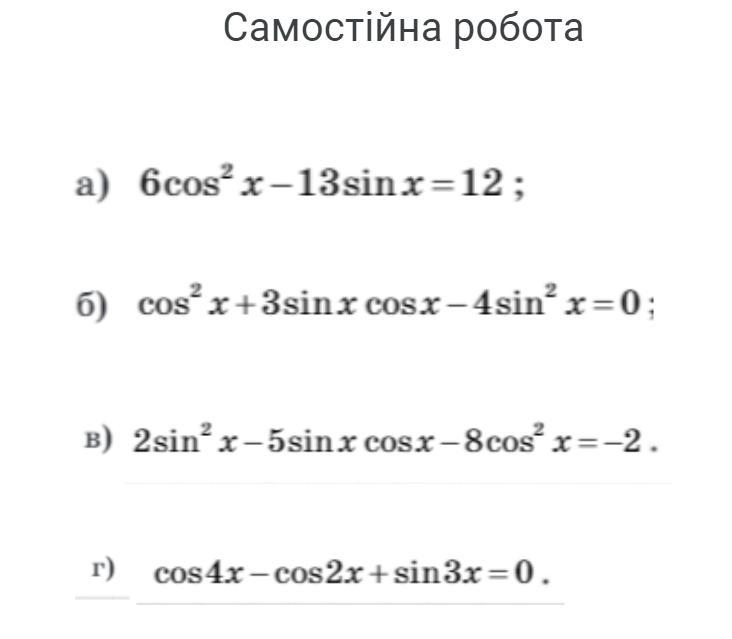6cos^(2)x-13sinx=12
cos^(2)x+3sinx cosx-4sin^(2)x=0
2sin^(2)x-5sinx cosx-8cos^(2)x=-2
cos4x-cos2x+sin3x=0

Ответы
Ответ:et's solve each equation one by one:
6cos^2x - 13sinx = 12
We can rewrite cos^2x in terms of sinx using the identity cos^2x = 1 - sin^2x:
6(1 - sin^2x) - 13sinx = 12
6 - 6sin^2x - 13sinx - 12 = 0
-6sin^2x - 13sinx - 6 = 0
Now we can use the quadratic formula:
sinx = (-(-13) ± √((-13)^2 - 4(-6)(-6))) / 2(-6)
sinx = (13 ± √(241)) / 12
So the solutions are sinx = (13 + √241) / 12 and sinx = (13 - √241) / 12.
cos^2x + 3sinx cosx - 4sin^2x = 0
We can rewrite cosx in terms of sinx using the identity cos^2x = 1 - sin^2x:
1 - sin^2x + 3sinx(√(1 - sin^2x)) - 4sin^2x = 0
Let's make a substitution u = sinx:
1 - u^2 + 3u(√(1 - u^2)) - 4u^2 = 0
(√(1 - u^2))(3u - 1) + (1 - 4u^2) = 0
(1 - 4u^2) = -(√(1 - u^2))(3u - 1)
Squaring both sides:
(1 - 4u^2)^2 = (1 - u^2)(3u - 1)^2
16u^4 - 24u^3 + 9u^2 - 2u + 1 = 0
This is a fourth-degree polynomial in u, which can be factored into:
(u - 1)(4u^3 - 20u^2 + 11u - 1) = 0
The first factor gives us the solution sinx = 1, which corresponds to x = π/2.
The cubic factor can be solved using numerical methods, or by using the rational root theorem to try out possible rational roots. One such root is u = 1/4, which corresponds to sinx = 1/4. We can then use the quadratic formula to find the other two solutions:
sinx = 1/4 ± √(17)/4
2sin^2x - 5sinx cosx - 8cos^2x = -2
We can rewrite cosx in terms of sinx using the identity cos^2x = 1 - sin^2x:
2sin^2x - 5sinx(√(1 - sin^2x)) - 8(1 - sin^2x) = -2
10sin^2x - 5sinx(√(1 - sin^2x)) - 6 = 0
Making a substitution u = sinx:
10u^2 - 5u(√(1 - u^2)) - 6 = 0
Let's make another substitution v = √(1 - u^2):
10(1 - v^2) - 5u v - 6 = 0
5u v - 10v^2 -
Объяснение:
Ответ:
6cos^2(x) - 13sin(x) = 12
Застосуємо тригонометричні тотожності для перетворення виразу:
6cos^2(x) - 13sin(x) = 12
6(1 - sin^2(x)) - 13sin(x) = 12
6 - 6sin^2(x) - 13sin(x) - 12 = 0
6sin^2(x) + 13sin(x) - 6 = 0
Застосуємо формулу дискримінанта, щоб знайти sin(x):
D = b^2 - 4ac = 13^2 - 4(6)(-6) = 325
sin(x) = (-b ± sqrt(D)) / 2a = (-13 ± sqrt(325)) / 12
Отже, розв'язками є sin(x) ≈ -1.16 та sin(x) ≈ 0.52.
cos^2(x) + 3sin(x)cos(x) - 4sin^2(x) = 0
Застосуємо тригонометричні тотожності для перетворення виразу:
cos^2(x) + 3sin(x)cos(x) - 4sin^2(x) = 0
cos^2(x) + 2sin(x)cos(x) + sin^2(x) + sin(x)cos(x) - 5sin^2(x) = 0
(cos(x) + sin(x))^2 - 5sin^2(x) = 0
(cos(x) + sin(x) - sqrt(5)sin(x))(cos(x) + sin(x) + sqrt(5)sin(x)) = 0
Таким чином, розв'язками є x = arcsin(-1/2), x = arccos((sqrt(5)-1)/2), та x = arccos(-(sqrt(5)+1)/2).
2sin^2(x) - 5sin(x)cos(x) - 8cos^2(x) = -2
Перетворимо праву частину виразу:
2sin^2(x) - 5sin(x)cos(x) - 8cos^2(x) = -2
2sin^2(x) - 5sin(x)cos(x) - 8(1-sin^2(x)) = -2
10sin^2(x) - 5sin(x)cos(x) - 6 = 0
Застосуємо формулу дискримінанта, щоб знайти sin(x):
D = b^2 - 4ac = 5^2 - 4(10)(-6) = 325
sin(x) = (-b ± sqrt(D)) / 2a = (5 ± sqrt(325)) / 20
Отже, розв'язками є sin(x) ≈ -0.27 та sin(x) ≈ 1.57.
cos(4x) - cos(2x) + sin(3x) = 0
Застосуємо тригонометри